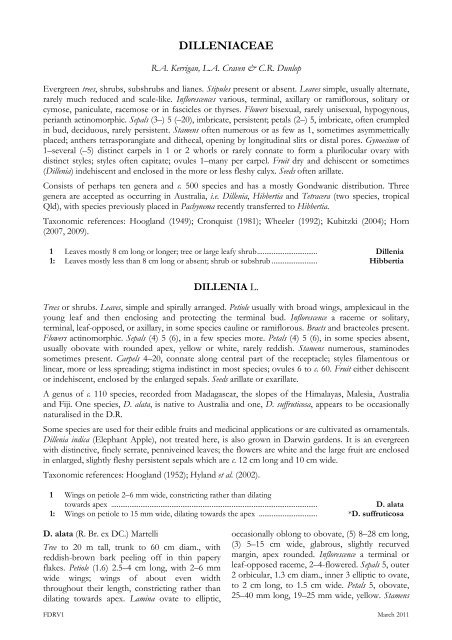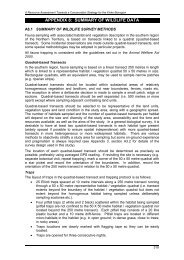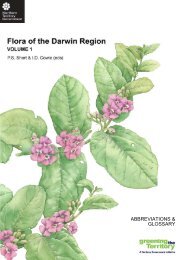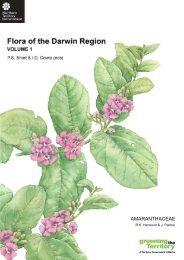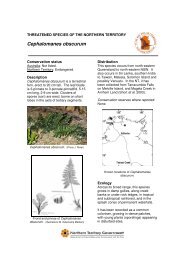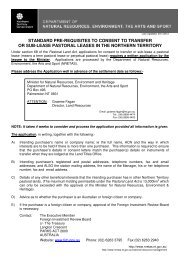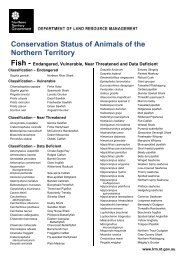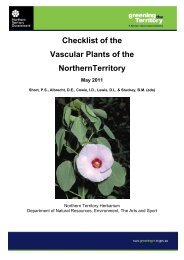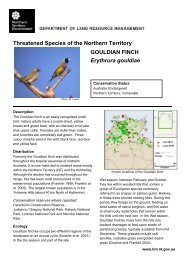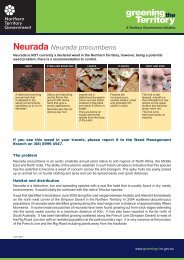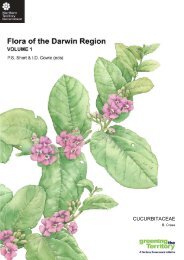DILLENIACEAE - Department of Land Resource Management ...
DILLENIACEAE - Department of Land Resource Management ...
DILLENIACEAE - Department of Land Resource Management ...
You also want an ePaper? Increase the reach of your titles
YUMPU automatically turns print PDFs into web optimized ePapers that Google loves.
<strong>DILLENIACEAE</strong><br />
R.A. Kerrigan, L.A. Craven & C.R. Dunlop<br />
Evergreen trees, shrubs, subshrubs and lianes. Stipules present or absent. Leaves simple, usually alternate,<br />
rarely much reduced and scale-like. Inflorescences various, terminal, axillary or ramiflorous, solitary or<br />
cymose, paniculate, racemose or in fascicles or thyrses. Flowers bisexual, rarely unisexual, hypogynous,<br />
perianth actinomorphic. Sepals (3–) 5 (–20), imbricate, persistent; petals (2–) 5, imbricate, <strong>of</strong>ten crumpled<br />
in bud, deciduous, rarely persistent. Stamens <strong>of</strong>ten numerous or as few as 1, sometimes asymmetrically<br />
placed; anthers tetrasporangiate and dithecal, opening by longitudinal slits or distal pores. Gynoecium <strong>of</strong><br />
1–several (–5) distinct carpels in 1 or 2 whorls or rarely connate to form a plurilocular ovary with<br />
distinct styles; styles <strong>of</strong>ten capitate; ovules 1–many per carpel. Fruit dry and dehiscent or sometimes<br />
(Dillenia) indehiscent and enclosed in the more or less fleshy calyx. Seeds <strong>of</strong>ten arillate.<br />
Consists <strong>of</strong> perhaps ten genera and c. 500 species and has a mostly Gondwanic distribution. Three<br />
genera are accepted as occurring in Australia, i.e. Dillenia, Hibbertia and Tetracera (two species, tropical<br />
Qld), with species previously placed in Pachynema recently transferred to Hibbertia.<br />
Taxonomic references: Hoogland (1949); Cronquist (1981); Wheeler (1992); Kubitzki (2004); Horn<br />
(2007, 2009).<br />
1 Leaves mostly 8 cm long or longer; tree or large leafy shrub................................. Dillenia<br />
1: Leaves mostly less than 8 cm long or absent; shrub or subshrub ......................... Hibbertia<br />
DILLENIA L.<br />
Trees or shrubs. Leaves, simple and spirally arranged. Petiole usually with broad wings, amplexicaul in the<br />
young leaf and then enclosing and protecting the terminal bud. Inflorescence a raceme or solitary,<br />
terminal, leaf-opposed, or axillary, in some species cauline or ramiflorous. Bracts and bracteoles present.<br />
Flowers actinomorphic. Sepals (4) 5 (6), in a few species more. Petals (4) 5 (6), in some species absent,<br />
usually obovate with rounded apex, yellow or white, rarely reddish. Stamens numerous, staminodes<br />
sometimes present. Carpels 4–20, connate along central part <strong>of</strong> the receptacle; styles filamentous or<br />
linear, more or less spreading; stigma indistinct in most species; ovules 6 to c. 60. Fruit either dehiscent<br />
or indehiscent, enclosed by the enlarged sepals. Seeds arillate or exarillate.<br />
A genus <strong>of</strong> c. 110 species, recorded from Madagascar, the slopes <strong>of</strong> the Himalayas, Malesia, Australia<br />
and Fiji. One species, D. alata, is native to Australia and one, D. suffruticosa, appears to be occasionally<br />
naturalised in the D.R.<br />
Some species are used for their edible fruits and medicinal applications or are cultivated as ornamentals.<br />
Dillenia indica (Elephant Apple), not treated here, is also grown in Darwin gardens. It is an evergreen<br />
with distinctive, finely serrate, penniveined leaves; the flowers are white and the large fruit are enclosed<br />
in enlarged, slightly fleshy persistent sepals which are c. 12 cm long and 10 cm wide.<br />
Taxonomic references: Hoogland (1952); Hyland et al. (2002).<br />
1 Wings on petiole 2–6 mm wide, constricting rather than dilating<br />
towards apex ................................................................................................................. D. alata<br />
1: Wings on petiole to 15 mm wide, dilating towards the apex ................................ *D. suffruticosa<br />
D. alata (R. Br. ex DC.) Martelli<br />
Tree to 20 m tall, trunk to 60 cm diam., with<br />
reddish-brown bark peeling <strong>of</strong>f in thin papery<br />
flakes. Petiole (1.6) 2.5–4 cm long, with 2–6 mm<br />
wide wings; wings <strong>of</strong> about even width<br />
throughout their length, constricting rather than<br />
dilating towards apex. Lamina ovate to elliptic,<br />
occasionally oblong to obovate, (5) 8–28 cm long,<br />
(3) 5–15 cm wide, glabrous, slightly recurved<br />
margin, apex rounded. Inflorescence a terminal or<br />
leaf-opposed raceme, 2–4-flowered. Sepals 5, outer<br />
2 orbicular, 1.3 cm diam., inner 3 elliptic to ovate,<br />
to 2 cm long, to 1.5 cm wide. Petals 5, obovate,<br />
25–40 mm long, 19–25 mm wide, yellow. Stamens<br />
FDRV1 March 2011


